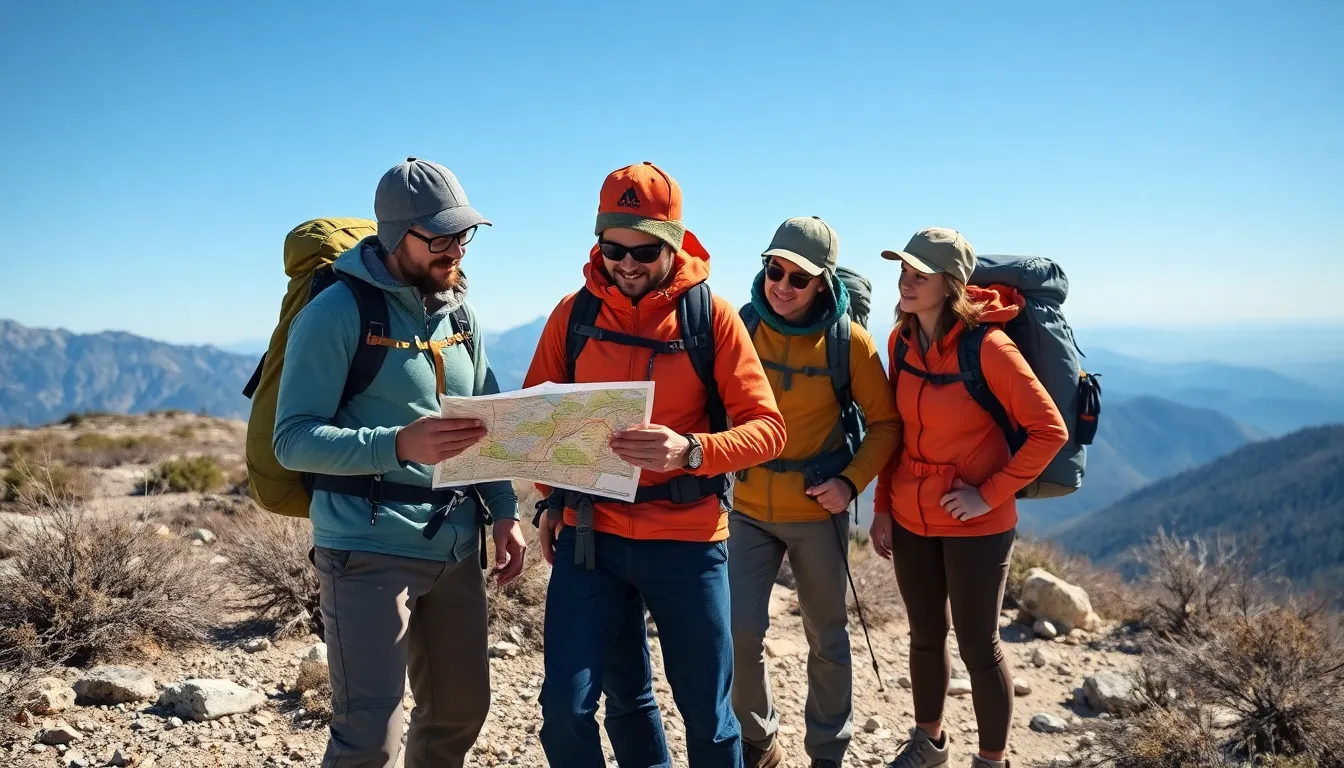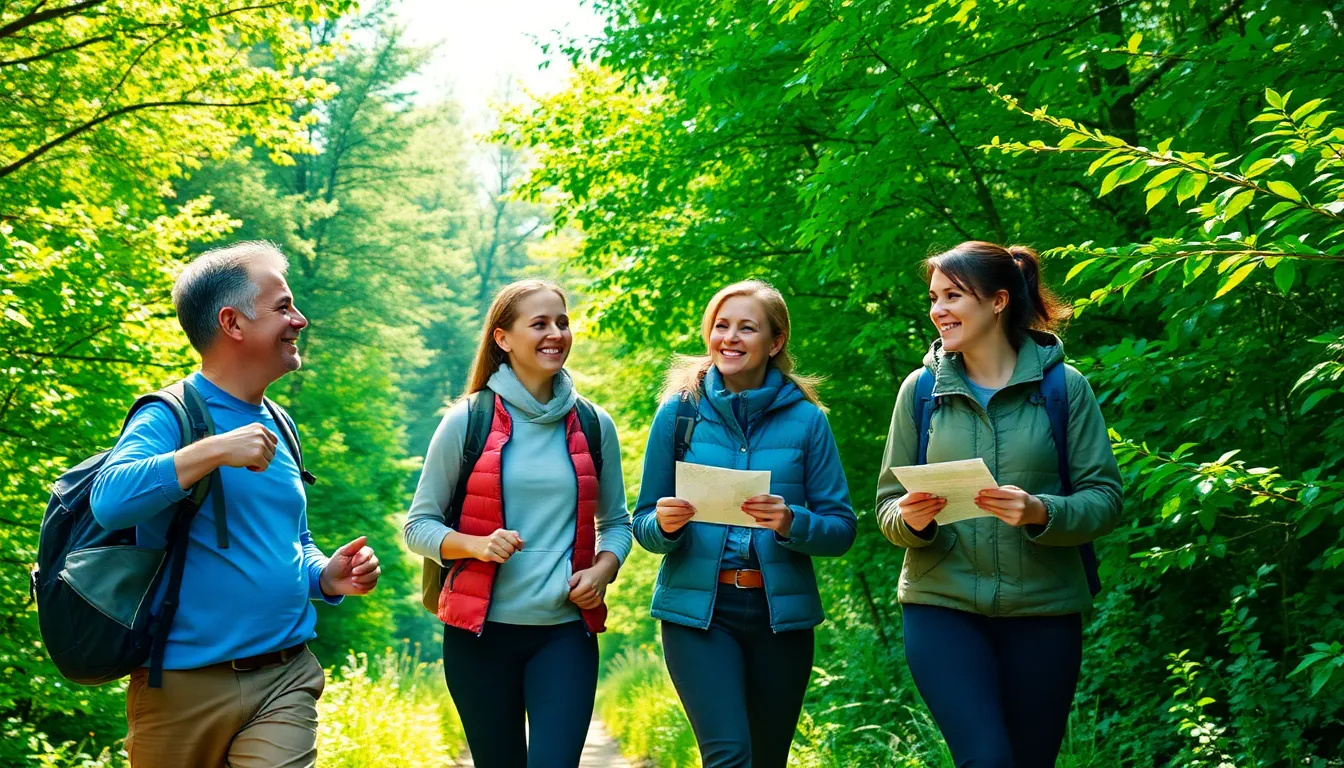Hiking can feel like a walk in the park—until it isn’t. One moment you’re enjoying the great outdoors, and the next, you’re wondering if that rustle in the bushes is a friendly squirrel or a bear with a taste for adventure. To keep those pesky worries at bay, it’s crucial to arm yourself with safe hiking tips that’ll have you strutting down the trail like a pro.
Table of Contents
ToggleUnderstanding Safe Hiking Tips
Hiking offers many benefits, including access to nature and physical activity. Prioritizing safety enhances enjoyment and minimizes risks.
Importance of Safety in Hiking
Safety in hiking ensures a positive experience. An increase in awareness about potential dangers helps hikers prepare better. Hikers equipped with knowledge about the terrain, weather, and wildlife navigate trails more effectively. Staying safe means planning routes, informing others of itineraries, and checking weather forecasts. Proper preparation prevents accidents and allows for prompt response in emergencies.
Common Hiking Risks
Hiking presents several risks that demand attention. Dehydration tops the list, as hikers often underestimate water needs. Wildlife encounters can also pose dangers, from snakes to bears. Poor foot placement increases the risk of slips and falls on uneven terrain. Exposure to changing weather conditions can quickly become hazardous, impacting visibility and comfort. Navigational errors may lead to getting lost, prompting panic and stress. Awareness of these risks allows hikers to take preventive measures.
Preparation for a Hike

Preparation enhances safety for hikers on the trails. Effective planning involves multiple key steps.
Planning Your Route
Selecting the right path is crucial. Identify trails that match fitness levels and hiking experience. Utilize maps and apps to understand elevation and terrain. Knowing the distance aids in setting a realistic timeline. Tell someone about the planned route and estimated return time for added safety. Anticipate potential hazards such as steep inclines or rocky sections. Consider options for shorter or alternate routes in case of emergencies. Keeping a printed map on hand remains beneficial in areas with limited signal.
Checking Weather Conditions
Checking weather forecasts is essential before heading out. Conditions can change rapidly in mountainous areas. Noting temperature and precipitation chances helps pack appropriate gear. Recognizing the risk of storms or extreme temperatures can prevent dangerous situations. Prepare for varying weather by including layers in the backpack. Rain gear and warm accessories become vital in cooler seasons. Monitoring weather apps throughout the hike ensures hikers stay informed. Always revise plans if severe weather threatens the safety of the adventure.
Essential Hiking Gear
Packing the right gear significantly enhances safety and comfort during hikes. Focusing on clothing and footwear helps hikers prepare for various trail conditions and weather.
Clothing and Footwear
Wearing moisture-wicking base layers keeps moisture away from the skin. Layered clothing provides flexibility to adapt to temperature changes throughout the day. Insulating layers, like fleece or down jackets, maintain warmth in cooler conditions. Waterproof outer layers protect against rain and wind, ensuring a dry experience. Comfortable, sturdy hiking boots offer crucial support and traction on uneven terrain. Hiking socks made from synthetic or wool materials reduce blisters and enhance comfort.
Safety Equipment
Carrying a first aid kit addresses potential injuries like cuts or sprains during hikes. A map and compass or GPS device help maintain navigation and prevent getting lost. Emergency whistle allows for quick communication in case of distress. Flashlight or headlamp increases visibility during early morning or late evening hikes. Sunscreen protects skin from harmful UV rays, especially at higher elevations. Lastly, sufficient water and snacks provide necessary hydration and energy throughout the hike.
During the Hike
Prioritizing safety during the hike is essential for enjoying the experience fully. Here are key considerations.
Staying on Marked Trails
Staying on marked trails helps prevent getting lost and minimizes the chances of disturbing wildlife. Follow signs and maps closely to maintain orientation. Paths designated for hiking often offer the safest footing, reducing risks of slips and injuries. Ignoring trail boundaries can lead to trampling of fragile ecosystems, which impacts local flora and fauna. Staying aware of where the trails lead fosters a deeper appreciation for nature while protecting it.
Hydration and Nutrition
Hydration is crucial throughout a hike to maintain energy levels. One should drink water regularly, not just when feeling thirsty. Carrying about half a liter of water per hour is a general guideline for moderate activity. Along with water, snacks rich in carbohydrates and protein are beneficial. Packing items such as trail mix, energy bars, or fruit provides a quick energy boost during breaks. Mixing hydration with nutritious snacks keeps energy sustained and enhances overall enjoyment.
Emergency Preparedness
Being prepared for emergencies during hiking enhances safety and confidence. Understanding first aid and knowing how to signal for help represent two crucial components of emergency preparedness.
First Aid Knowledge
First aid knowledge equips hikers with skills to manage injuries or health issues on the trail. Learning basic techniques such as CPR, wound care, and how to recognize symptoms of heat exhaustion or hypothermia can make a significant difference. Carrying a well-stocked first aid kit complements this knowledge. Essential items include adhesive bandages, antiseptic wipes, and pain relievers. Familiarizing oneself with the kit ensures efficient access to supplies when needed. Additionally, practicing first aid techniques can boost response times during emergencies.
Signaling for Help
Signaling for help requires a clear understanding of effective methods. Whistles represent one of the best tools for signaling, as their sound travels farther than a person’s voice. A bright-colored reflective emergency blanket can serve multiple purposes, including signaling and warmth. Hikers should also carry a flashlight which can be useful in low-light conditions. Additionally, using a signal mirror can attract attention from a distance. Knowing the local emergency numbers and carrying a fully charged mobile phone offer direct communication in critical situations. By preparing to signal for help, hikers increase their chances of a swift rescue.
Conclusion
Embracing the outdoors through hiking offers incredible benefits but also comes with inherent risks. By prioritizing safety and preparation hikers can enjoy their adventures with peace of mind. Understanding the terrain weather conditions and necessary gear is crucial for a successful outing.
Moreover staying hydrated and nourished throughout the hike ensures energy levels remain high. Learning basic first aid and having emergency signaling tools can make a significant difference in critical situations.
With these safe hiking tips in mind anyone can confidently explore the beauty of nature while minimizing potential dangers. Whether it’s a short day hike or an extended trek being well-prepared is the key to a rewarding experience on the trails.



